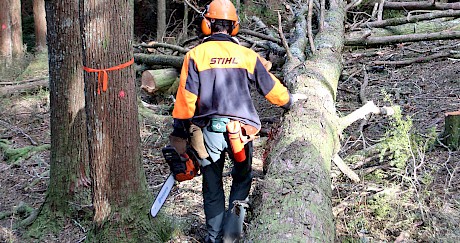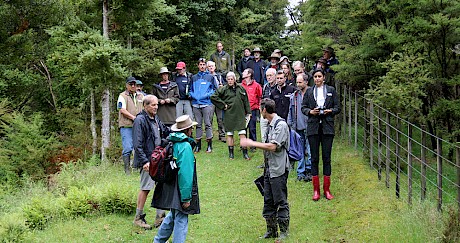Matai (Prumnopitys taxifolia)
History
In the Wanganui region, where totara was not common, the Maori used the wood of matai for carving. Its other uses were for canoes, canoe bailers, small agricultural implements and handles. The Maori also drank the liquid (matai beer) obtained from the cracks in heart matai to treat consumption and as an antiseptic. The advent of the European found matai attaining an exaggerated reputation for durability and its unwise use for house blocks and fence posts; matai is not durable, being similar in that regard to kauri. It is however a superb above ground timber with excellent machining qualities, stability and hardness. It is especially suited to heavy duty floors and wooden door and window joinery. Bushmen used to drill into hollow matai to tap the “matai beer” and they too used it to check consumption and as an antiseptic.
Distribution
 Matai bark. Its most distinctive feature is its “hammer marked” bark scales that are pale on the inside. Photo: H Janssen, Bush Vitality AssessmentMatai is found throughout New Zealand and very rarely on Stewart Island. It is most common in the Central Plateau in the North Island with other important areas being the West Coast, SE Nelson, the Seaward Kaikouras and western Southland in the South Island. In the North Island it grows from sea level to 760 metres and in the South Island to 300 metres. It appears to favour warmer areas with moist but well drained alluvial soils of the type usually found on river terraces. There is some indication that it grows better at a higher pH then most other podocarps and reputedly forms mor soils.
Matai bark. Its most distinctive feature is its “hammer marked” bark scales that are pale on the inside. Photo: H Janssen, Bush Vitality AssessmentMatai is found throughout New Zealand and very rarely on Stewart Island. It is most common in the Central Plateau in the North Island with other important areas being the West Coast, SE Nelson, the Seaward Kaikouras and western Southland in the South Island. In the North Island it grows from sea level to 760 metres and in the South Island to 300 metres. It appears to favour warmer areas with moist but well drained alluvial soils of the type usually found on river terraces. There is some indication that it grows better at a higher pH then most other podocarps and reputedly forms mor soils.
Tree size and growth
Matai grows to 25 metres (rarely 30m) in height with diameters up to1.3 metres. The largest recorded tree, at Lake Ianthe south of Hokitika, is 23 metres tall and 2.35 metres in diameter and is reputed to be over 1000 years old. Growth rates of naturally grown trees are very slow with the fastest recorded growth rate being about 1mm annually. Planted matai is likewise slow with height growth of saplings and poles averaging 20 cm annually. Diameter growth ranges from 2 to 5 mm annually.
Timber
Timber characteristics, with P radiata figures shown in brackets for comparison, are as follows: -
Density: 610kg/ m³ (500 kg/m³ )
Moisture content: green heart 88% (130%)
Tangential shrinkage -green to 12% m.c 3.5% (4.7%)
Radial shrinkage 1.9% (2.2%)
Modulus of rupture 76Mpa (90 Mpa)
Modulus of elasticity 8.1Gpa (9 Gpa)
Potential
Because of its apparently slow growth rate, matai will probably never be important as a species planted for timber. However, its timber qualities and ability to grow in shaded situations are such that it should be considered as a minor species for continuous cover forestry.
Research requirements
There is a need to locate good parent trees and trial the growth rates of seedlings under a variety of conditions. Its apparent requirement for better quality soils suggests that it should be tested first on high quality sites. Matai may well grow faster than we realize!
References
- Allan H H 1961. Flora of New Zealand Vol. 1 Government Printer Wellington
- Brooker S G, Cambie R C & Cooper R C 1981. New Zealand Medicinal Plants. Heinmann
- Brooker S G, Cambie R C & Cooper R C 1988. Economic Native Plants of New Zealand. Botany Division, D.S.I.R
- Burstal S W & Sale E V 1984. Great Trees of New Zealand
- Clifton N C 1990. New Zealand timbers
- Farjon A 2001. World Checklist and bibliography of Conifers (2nd ed) Royal Botanical Gardens, Kew
- Hinds H V & Reid J S 1957. Forest Trees and Timbers of New Zealand. Govt Printer Wellington
- Pardy G F, Bergin D O & Kimberley M O 1992. Survey of Native tree plantations. FRI Bulletin 175
Species profile by Ian Barton


